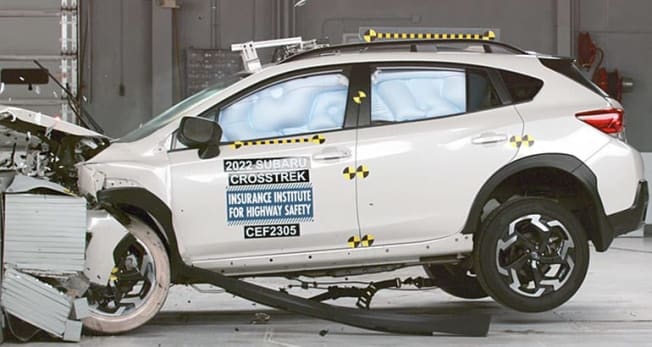Small Cars Lag in Rear-Seat Safety, New IIHS Crash Tests Show
The results follow similar findings from SUV crash tests and show that automakers can make rear seats safer

Three out of the five popular small cars recently crash-tested by the Insurance Institute for Highway Safety (IIHS) received its lowest overall rating, mostly due to their failure to provide good protection to rear-seat passengers. None of the cars were given a top rating. It’s further confirmation that automakers still have work to do in terms of better protection for rear-seat occupants.

Photo: IIHS Photo: IIHS
This is the third round of vehicles the IIHS has put through its updated “moderate overlap” frontal test; the first round of tests on small and midsized SUVs showed similar results. The test is representative of crashes in which two vehicles driving in opposite directions hit each other at 40 mph but not head-on—the type of collision that would occur if one car drifted across the center line of a roadway, for example. In addition to a dummy representing an adult male in the driver seat, the test now features a dummy in the second row that represents a small woman or a 12-year-old child, because it more closely matches the average size of a rear-seat passenger than other dummies available.
The IIHS, which is funded by the insurance industry, says it plans to test more vehicles—including the updated Crosstrek—in the future. There’s a good chance that these scores will improve as automakers redesign vehicles to meet the new test standards, says Emily Thomas, manager of auto safety at Consumer Reports’ auto test center.

Photo: IIHS Photo: IIHS
“This is the first batch of small cars tested, and there’s really no reason why these cars can’t score better,” she says. “We often see low scores in the first round of tests, but manufacturers typically rise to the occasion.”
One way both IIHS and Thomas say automakers could improve rear occupant safety is through better implementation of pretensioners, which tighten the belt at the onset of a crash, and load limiters, which let the belt spool out a bit to reduce any jerking force that might injure the occupant’s chest. These safety features are found in the front seats of most new vehicles, but they aren’t always found in rear seating positions. And while these features are standard in the rear seats of the Civic, Corolla, and Sentra, the results of the IIHS crash tests indicate that automakers may need to make some changes to improve how they perform.
According to Thomas, the Sentra’s Poor score is proof that simply equipping cars with load limiters and pretensioners isn’t enough. “It appears that even though Nissan did put these features into their cars, they could use some work in improving the implementation of the systems,” she says.
Kia, Nissan, and Subaru did not respond to CR’s request for comment about the new scores.
All rear occupants should make sure to buckle up on every ride. In a 2017 IIHS study, only 74 percent of passengers reported buckling up in the rear seat of vehicles, compared with 91 percent of front-seat passengers, even though unbelted rear-seat occupants are eight times more likely to be injured and twice as likely to die as belted rear-seat occupants in a crash. When scoring a vehicle, CR also considers whether or not it is equipped with belt minders in the rear seats to help improve rear seat belt usage.
“The back seat is still the safest place for your child, regardless of whether they’re in a harnessed car seat or booster,” says Thomas.
















